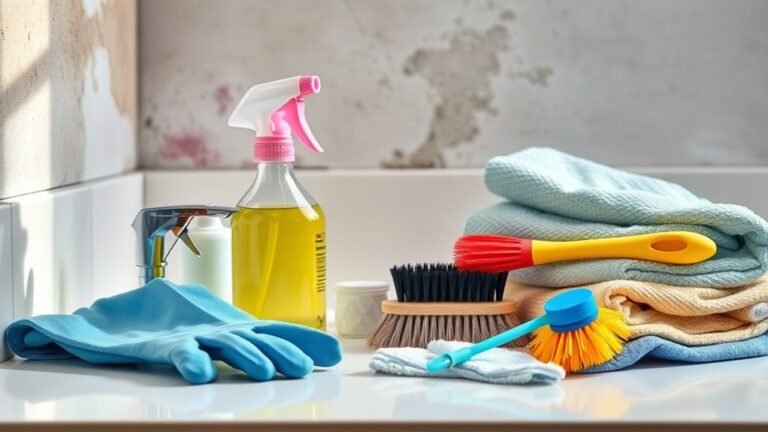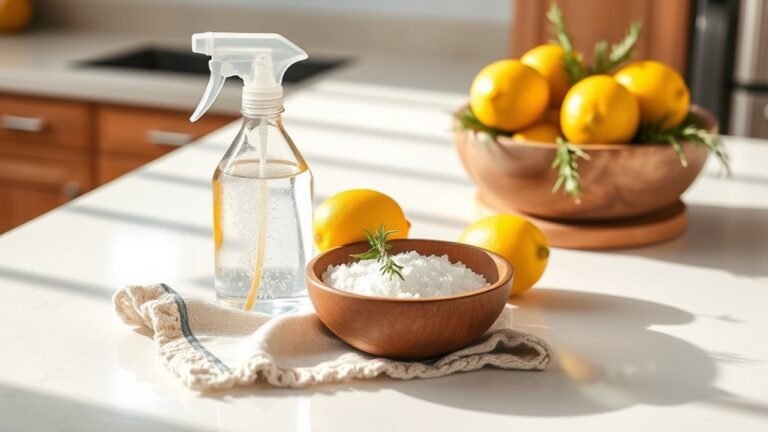Removing Tile Stains From Grease
If you want to remove grease stains from your tiles, start by gathering mild detergent, baking soda, vinegar, and a soft brush. For stubborn stains, apply a baking soda and vinegar paste, let it sit 10-15 minutes, then scrub gently in circles. Dish soap with warm water also works well to break down grease without harming your tiles. Understanding your tile type helps you choose the best method. Keep going to discover more tips for maintaining spotless, grease-free tiles.
Understanding the Causes of Grease Stains on Tiles

Although grease stains on tiles might seem stubborn, understanding their causes can help you prevent and treat them effectively. Grease sources often include cooking oils, butter, and food splatters, typically found in kitchens where tile types vary from ceramic to porcelain and natural stone. Each tile type interacts differently with grease; porous tiles absorb stains more readily, while glazed tiles resist penetration but still trap residue on the surface. Knowing these distinctions allows you to tailor your cleaning approach. By identifying where grease originates and recognizing your tile’s composition, you can avoid damage and select proper stain removal methods. This knowledge empowers you to maintain tile freedom from stains without unnecessary effort or harsh treatments, preserving both the tile’s appearance and your independence in upkeep.
Preparing Your Cleaning Supplies
Before tackling grease stains, gather three essential cleaning supplies: a mild detergent, a soft brush or cloth, and a suitable stain remover based on your tile type. Choose cleaning tools that won’t damage your tiles—soft brushes work best on delicate surfaces, while sturdier brushes can handle tough stains on durable tiles. Always check the label of your stain remover to confirm compatibility. Next, set up a well-ventilated workspace to minimize exposure to fumes. Wearing gloves and protective eyewear are key safety precautions to protect your skin and eyes from harsh chemicals. Keep all cleaning tools organized and within reach to streamline the process. By preparing thoughtfully and respecting safety precautions, you’ll tackle grease stains efficiently and keep your tile surfaces unharmed.
Using Baking Soda and Vinegar for Effective Stain Removal

Start by mixing baking soda with a small amount of water to create a thick paste. Apply the paste directly onto the stained tile, then spray or pour vinegar over it to activate the cleaning reaction. Use a scrub brush or sponge to gently scrub the area, focusing on the stain until it lifts.
Preparing the Cleaning Paste
To prepare an effective cleaning paste for tile stains, you’ll need just two common ingredients: baking soda and vinegar. These cleaning paste ingredients combine to create a gentle yet powerful solution that breaks down grease and lifts stains. Start by mixing three tablespoons of baking soda with enough vinegar to form a spreadable paste. The fizzing action signals that it’s ready to tackle grime.
Consider these paste application methods to maximize effectiveness:
- Apply the paste directly to stained areas using a spatula or your fingers.
- Confirm the paste covers the stain evenly for consistent cleaning.
- Let the paste sit for 10-15 minutes to penetrate tough grease before scrubbing.
Applying and Scrubbing Technique
Once your cleaning paste is ready and evenly applied, it’s time to focus on the scrubbing technique that will lift the stains effectively. Using the right scrubbing tools and cleaning techniques guarantees you don’t damage your tiles while removing grease. A soft-bristle brush works well for delicate surfaces, while a stiff brush tackles tougher grime.
| Scrubbing Tool | Best For | Cleaning Technique |
|---|---|---|
| Soft-bristle brush | Delicate tiles | Gentle circular motion |
| Stiff brush | Stubborn grease stains | Firm back-and-forth |
| Sponge | Light stains | Light pressure, dabbing |
Apply steady pressure as you scrub in circular motions, then rinse with warm water. Repeat if necessary to free your tiles from grease without risking damage.
Applying Dish Soap and Warm Water to Break Down Grease
To tackle grease stains on your tiles, start by selecting a dish soap known for cutting through oil. Mix a small amount of the soap with warm water to create an effective cleaning solution. Then, use a soft brush or cloth to scrub the stained area gently but thoroughly.
Choosing the Right Dish Soap
Although many dish soaps can remove grease, choosing one with strong degreasing agents will make breaking down tile stains much easier. When selecting dish soap for effective grease removal, focus on these qualities:
- Powerful formula: Look for dish soaps labeled “degreaser” or “heavy-duty” to tackle tough stains efficiently.
- Concentrated solution: Concentrates require less product and provide stronger grease-cutting action.
- Gentle on surfaces: Choose a dish soap that won’t damage your tile finish while removing grease.
Using the right dish soap streamlines your cleaning process and guarantees stubborn grease stains don’t stand a chance. By picking a product designed for grease removal, you gain freedom from scrubbing endlessly and achieve cleaner tiles with less effort.
Preparing Warm Water Solution
Two key ingredients—warm water and dish soap—work together to break down grease on your tiles effectively. Start by selecting water at a comfortable warm temperature; this helps dissolve grease without damaging tile surfaces. Next, focus on the solution ratio to maximize cleaning power without waste. A balanced mix guarantees the soap activates properly.
| Step | Details |
|---|---|
| Water Temperature | Use warm water (around 40-50°C) |
| Dish Soap Amount | 1 tablespoon per gallon of water |
| Mixing | Stir gently until soap dissolves |
| Application | Use immediately for best results |
This method preps a powerful cleaning solution, freeing you from stubborn grease stains efficiently.
Effective Stain Scrubbing Techniques
Once you’ve prepared your warm water and dish soap solution, the next step is applying it effectively to tackle grease stains. To maximize stain removal, you’ll want to choose the right scrubbing tools and techniques. Start by dipping a soft-bristle brush or sponge into the solution, then apply it generously to the stained tile. Use gentle, circular motions to break down the grease without damaging the surface. For tougher spots, try these methods:
- Use a nylon scrub brush for deeper scrubbing without scratching.
- Apply consistent pressure to lift the stain without spreading it.
- Rinse frequently to check progress and avoid residue buildup.
Scrubbing Techniques for Different Types of Tile Surfaces
When scrubbing tile surfaces, it’s important to match your technique to the tile type to avoid damage and guarantee effective stain removal. For ceramic tiles, use a soft brush with a mild detergent to avoid scratching the glaze. Porcelain tiles are denser; a nylon brush works well to lift grease without harming the surface. Focus on grout cleaning by applying a paste of baking soda and water, scrubbing gently to remove stains without eroding grout lines. Natural stone demands extra care—avoid acidic cleaners and use a pH-neutral solution with a soft cloth or sponge. Always rinse thoroughly after scrubbing to prevent residue buildup. Tailoring your approach lets you clean efficiently while keeping your tiles in top condition and freeing you from unnecessary risks or damage.
Preventative Tips to Keep Tiles Grease-Free Longer

Although regular cleaning removes existing grease, taking preventative measures can substantially extend the time your tiles stay spotless. Effective grease prevention starts with consistent tile maintenance routines designed to minimize buildup before it sets in.
To keep your tiles grease-free longer, focus on:
- Wiping surfaces immediately after cooking or spills to avoid grease settling.
- Using mats or splatter guards near greasy areas to reduce airborne grease particles.
- Applying a tile sealant to create a protective barrier that repels oils and makes cleaning easier.
Frequently Asked Questions
Can Grease Stains Damage Tile Grout Permanently?
Imagine a sponge soaking up oil — that’s what happens when grease meets your tile grout. You might worry that grout discoloration is permanent, but it usually depends on how long the grease absorption has occurred. If you tackle stains quickly, you can usually avoid lasting damage. However, if grease sits too long, it can seep deep, making discoloration stubborn or permanent. So, acting fast gives you more freedom to restore your grout’s look.
Are There Eco-Friendly Alternatives to Vinegar for Grease Removal?
Yes, you can use eco-friendly alternatives to vinegar for grease removal. Baking soda is a great option; it’s natural, non-toxic, and effective at breaking down grease. You can mix it with water to form a paste, apply it to the stain, then scrub gently. Adding a few drops of essential oils like lemon or tea tree not only boosts cleaning power but also leaves a fresh scent. This combo keeps your space clean and green.
How Often Should Tile Grout Be Resealed to Prevent Stains?
You might think grout maintenance is a one-time task, but sealing frequency plays a vital role in keeping your grout stain-free. Typically, you should reseal grout every 1 to 2 years, depending on usage and exposure to moisture. Regular sealing creates a protective barrier, making cleaning easier and preserving grout’s appearance. Staying consistent with this simple step gives you the freedom to enjoy your tiles without worrying about stains or damage.
Can Professional Cleaning Services Remove Old, Stubborn Grease Stains?
Yes, professional cleaning services can effectively tackle old, stubborn grease stains using advanced grease removal techniques. They employ specialized equipment and powerful cleaning agents designed to break down and lift grease deep within tile surfaces and grout. By letting experts handle this, you save time and effort while ensuring a thorough clean. This way, you regain your tile’s original look without the hassle of DIY scrubbing.
Is It Safe to Use Bleach on Grease-Stained Tiles?
You might wonder about bleach effectiveness on grease-stained tiles. While bleach can remove stains, it’s not always safe for all tile types—especially natural stone, which it can damage. To protect tile safety, test bleach on a small, hidden spot first. If you choose to use it, dilute properly and ventilate the area well. For stubborn stains, safer alternatives like baking soda or commercial cleaners designed for tiles might be better options.






